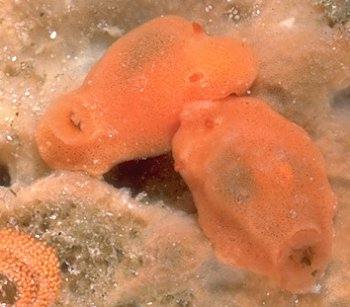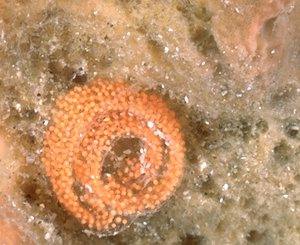

Rostanga bassia
Rudman & Avern, 1989
Order: NUDIBRANCHIA
Suborder: DORIDINA
Superfamily: EUDORIDOIDEA
Family: Dorididae
DISTRIBUTION
At present R. bassia is known only from the Bass Strait coast of Victoria, Australia.
PHOTO
S. of West Head, Flinders, Westernport Bay, Victoria, Australia. intertidal; three specimens (22, 23 mm long alive), 4 March 1986, PARATYPES-AM C149516. Upper: animals on food sponge, Clathria (Thalysias) cactiformis. Lower: egg mass showing large direct developing eggs. PHOTO: Bill Rudman.
See also R. bassia - Radula.
The animal is a bright orange to reddish orange with scattered dark brown marks, sometimes small specks spread uniformly over the mantle between caryophyllidia and at other times forming quite large irregular patches. The caryophyllidia are translucent orange often with white streaking on the basal half of the stalk. The mantle glands consist of white globules embedded in the mantle epithelium and they form a submarginal row of white spots. There are sometimes white pigment specks right at the mantle edge. The rhinophore stalk is transparent and the club translucent orange. The gills are translucent orange with some white and brown speckling. The body is similar in shape to R. arbutus except for the shape of the rhinophores which have a series of vertical lamellae and a stalked knob in the posterior midline.
The egg ribbon, which has been found atttached to the food sponge, is thick, rigid and jelly-like with large bright orange eggs arranged in a spiral of approximately two coils. It is characteristic of direct development. Specimens from Victoria were found in a shaded crevice exposed at extreme low tide on a large lobulate red-orange poeciloscierid sponge, Clathria (Thalysias) cactiformis (Lamarck, 1813) (Family Microcionidae).
Rostanga bassia has no external features which clearly distinguish it from other red species with vertically arranged rhinophore lamellae. The radular teeth are similar in shape to those of R. muscula from New Zealand except for the innermost lateral tooth. It differs from that species in having much larger jaw plates and a quite different egg ribbon. At present R. bassia is known only from the Bass Strait coast of Victoria, Australia, from which its name is derived.
Referenece:
• Rudman, W.B. & Avern, G.J. (1989) The genus Rostanga Bergh, 1879 (Nudibranchia:
Dorididae) in the Indo-West Pacific. Zoological Journal of the Linnean Society 96: 281-338.
Rudman, W.B., 2002 (February 4) Rostanga bassia Rudman & Avern, 1989. [In] Sea Slug Forum. Australian Museum, Sydney. Available from http://www.seaslugforum.net/factsheet/rostbass
